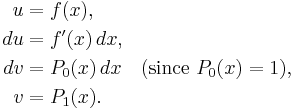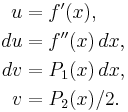Euler–Maclaurin formula
In mathematics, the Euler–Maclaurin formula provides a powerful connection between integrals (see calculus) and sums. It can be used to approximate integrals by finite sums, or conversely to evaluate finite sums and infinite series using integrals and the machinery of calculus. For example, many asymptotic expansions are derived from the formula, and Faulhaber's formula for the sum of powers is an immediate consequence.
The formula was discovered independently by Leonhard Euler and Colin Maclaurin around 1735 (and later generalized as Darboux's formula). Euler needed it to compute slowly converging infinite series while Maclaurin used it to calculate integrals.
Contents |
The formula
If n is a natural number and f(x) is a smooth (meaning: sufficiently often differentiable) function defined for all real numbers x between 0 and n, then the integral
can be approximated by the sum (or vice versa)
(see trapezoidal rule). The Euler–Maclaurin formula provides expressions for the difference between the sum and the integral in terms of the higher derivatives ƒ(k) at the end points of the interval 0 and n. Explicitly, for any natural number p, we have
where B1 = −1/2, B2 = 1/6, B3 = 0, B4 = −1/30, B5 = 0, B6 = 1/42, B7 = 0, B8 = −1/30, ... are the Bernoulli numbers, and R is an error term which is normally small for suitable values of p. (The formula is often written with the subscript taking only even values, since the odd Bernoulli numbers are zero except for B1.)
Note that
Hence, we may also write the formula as follows:
By using the substitution rule, one can adapt this formula also to functions ƒ which are defined on some other interval of the real line.
The remainder term
The remainder term R is most easily expressed using the periodic Bernoulli polynomials Pn(x). The Bernoulli polynomials Bn(x), n = 0, 1, 2, ... are defined recursively as
Then the periodic Bernoulli functions Pn are defined as
where  denotes the largest integer that is not greater than x. Then, in terms of Pn(x), the remainder term R can be written as
denotes the largest integer that is not greater than x. Then, in terms of Pn(x), the remainder term R can be written as
or equivalently, integrating by parts, assuming ƒ(2p) is differentiable again and recalling that the odd Bernoulli numbers are zero:
When n > 0, it can be shown that
where ζ denotes the Riemann zeta function (see Lehmer; one approach to prove the inequality is to obtain the Fourier series for the polynomials Bn). The bound is achieved for even n when x is zero. Using this inequality, the size of the remainder term can be estimated using
Applications
The Basel problem
The Basel problem asks to determine the sum
Euler computed this sum to 20 decimal places with only a few terms of the Euler–Maclaurin formula in 1735. This probably convinced him that the sum equals π2 / 6, which he proved in the same year.[1]
Sums involving a polynomial
If f is a polynomial and p is big enough, then the remainder term vanishes. For instance, if f(x) = x3, we can choose p = 2 to obtain after simplification
(see Faulhaber's formula).
Numerical integration
The Euler–Maclaurin formula is also used for detailed error analysis in numerical quadrature. It explains the superior performance of the trapezoidal rule on smooth periodic functions and is used in certain extrapolation methods. Clenshaw–Curtis quadrature is essentially a change of variables to cast an arbitrary integral in terms of integrals of periodic functions where the Euler–Maclaurin approach is very accurate (in that particular case the Euler–Maclaurin formula takes the form of a discrete cosine transform). This technique is known as a periodizing transformation.
Asymptotic expansion of sums
In the context of computing asymptotic expansions of sums and series, usually the most useful form of the Euler–Maclaurin formula is
where a and b are integers.[2] Often the expansion remains valid even after taking the limits  or
or  , or both. In many cases the integral on the right-hand side can be evaluated in closed form in terms of elementary functions even though the sum on the left-hand side cannot. Then all the terms in the asymptotic series can be expressed in terms of elementary functions. For example,
, or both. In many cases the integral on the right-hand side can be evaluated in closed form in terms of elementary functions even though the sum on the left-hand side cannot. Then all the terms in the asymptotic series can be expressed in terms of elementary functions. For example,
Here the left-hand side is equal to  , namely the first-order polygamma function defined through
, namely the first-order polygamma function defined through  ; the gamma function
; the gamma function  is equal to
is equal to  if
if  is a positive integer. This results in an asymptotic expansion for
is a positive integer. This results in an asymptotic expansion for  . That expansion, in turn, serves as the starting point for one of the derivations of precise error estimates for Stirling's approximation of the factorial function.
. That expansion, in turn, serves as the starting point for one of the derivations of precise error estimates for Stirling's approximation of the factorial function.
Proofs
Derivation by mathematical induction
We follow the argument given in (Apostol).[3]
The Bernoulli polynomials Bn(x), n = 0, 1, 2, ... may be defined recursively as follows:
The first several of these are
The values Bn(0) are the Bernoulli numbers. Notice that for n ≥ 2 we have
We define the periodic Bernoulli functions Pn by
where  denotes the largest integer that is not greater than x. So Pn agree with the Bernoulli polynomials on the interval (0, 1) and are periodic with period 1. Thus,
denotes the largest integer that is not greater than x. So Pn agree with the Bernoulli polynomials on the interval (0, 1) and are periodic with period 1. Thus,
For n = 1,
Let k be an integer, and consider the integral
where
Integrating by parts, we get
Summing the above from k = 0 to k = n − 1, we get
Adding (ƒ(0) + ƒ(n))/2 to both sides and rearranging, we have
The last two terms therefore give the error when the integral is taken to approximate the sum.
Next, consider
where
Integrating by parts again, we get,
Then summing from k = 0 to k = n − 1, and then replacing the last integral in (1) with what we have thus shown to be equal to it, we have
By now the reader will have guessed that this process can be iterated. In this way we get a proof of the Euler–Maclaurin summation formula by mathematical induction, in which the induction step relies on integration by parts and on the identities for periodic Bernoulli functions.
Derivation by functional analysis
The Euler–MacLaurin formula can be understood as a curious application of some ideas from Hilbert spaces and functional analysis.
First we restrict the problem to the domain of the unit interval [0,1]. Let  be the Bernoulli polynomials. A set of functions dual to the Bernoulli polynomials are given by
be the Bernoulli polynomials. A set of functions dual to the Bernoulli polynomials are given by
where δ is the Dirac delta function. The above is a formal notation for the idea of taking derivatives at a point; thus one has
for n > 0 and some arbitrary but differentiable function ƒ(x) on the unit interval. For the case of n = 0, one defines  . The Bernoulli polynomials, along with their duals, form an orthogonal set of states on the unit interval: one has
. The Bernoulli polynomials, along with their duals, form an orthogonal set of states on the unit interval: one has
and
The Euler–MacLaurin summation formula then follows as an integral over the latter. One has
Then setting x = 0 and rearranging terms, one obtains an expression for ƒ(0). Note that the Bernoulli numbers are defined as Bn = Bn(0), and that these vanish for odd n greater than 1.
Then, using the periodic Bernoulli function Pn defined above and repeating the argument on the interval [1,2], one can obtain an expression of ƒ(1). This way one can obtain expressions for ƒ(n), n = 0, 1, 2, ..., N, and adding them up gives the Euler–MacLaurin formula. Note that this derivation does assume that ƒ(x) is sufficiently differentiable and well-behaved; specifically, that ƒ may be approximated by polynomials; equivalently, that ƒ is a real analytic function.
The Euler–MacLaurin summation formula can thus be seen to be an outcome of the representation of functions on the unit interval by the direct product of the Bernoulli polynomials and their duals. Note, however, that the representation is not complete on the set of square-integrable functions. The expansion in terms of the Bernoulli polynomials has a non-trivial kernel. In particular, sin(2πnx) lies in the kernel; the integral of sin(2πnx) is vanishing on the unit interval, as is the difference of its derivatives at the endpoints.
See also
Notes
- ^ David J. Pengelley, "Dances between continuous and discrete: Euler's summation formula", in: Robert Bradley and Ed Sandifer (Eds), Proceedings, Euler 2K+2 Conference (Rumford, Maine, 2002), Euler Society, 2003.
- ^ Abramowitz & Stegun (1972), 23.1.30
- ^ Apostol, T. M. (1 May 1999). "An Elementary View of Euler's Summation Formula". The American Mathematical Monthly (Mathematical Association of America) 106 (5): 409–418. doi:10.2307/2589145. ISSN 00029890. JSTOR 2589145.
References
- Abramowitz, Milton; Stegun, Irene A., eds (1972). Handbook of Mathematical Functions with Formulas, Graphs, and Mathematical Tables. New York: Dover Publications. ISBN 978-0-486-61272-0. tenth printing., pp. 16, 806, 886
- Weisstein, Eric W., "Euler–Maclaurin Integration Formulas" from MathWorld.
- Pierre Gaspard, "r-adic one-dimensional maps and the Euler summation formula", Journal of Physics A, 25 (letter) L483–L485 (1992). (Describes the eigenfunctions of the transfer operator for the Bernoulli map)
- Xavier Gourdon and Pascal Sebah, Introduction on Bernoulli's numbers, (2002)
- D.H. Lehmer, "On the Maxima and Minima of Bernoulli Polynomials", American Mathematical Monthly, volume 47, pages 533–538 (1940)
- Hugh L. Montgomery; Robert C. Vaughan (2007). Multiplicative number theory I. Classical theory. Cambridge tracts in advanced mathematics. 97. pp. 495–519. ISBN 0-521-84903-9.
























![\begin{align}
\int_k^{k%2B1} f(x)\,dx &= uv - \int v\,du &{}\\
&= \Big[f(x)P_1(x) \Big]_k^{k%2B1} - \int_k^{k%2B1} f'(x)P_1(x)\,dx \\[8pt]
&=-B_1(f(k) %2B f(k%2B1)) - \int_k^{k%2B1} f'(x)P_1(x)\,dx.
\end{align}](/2012-wikipedia_en_all_nopic_01_2012/I/3a97818935df4c27c017889991e4165b.png)




![\begin{align}
uv - \int v\,du &{}= \left[ {f'(x)P_2(x) \over 2} \right]_k^{k%2B1} - {1 \over 2}\int_k^{k%2B1} f''(x)P_2(x)\,dx \\ \\
&{}= {B_2 \over 2}(f'(k%2B1) - f'(k)) - {1 \over 2}\int_k^{k%2B1} f''(x)P_2(x)\,dx.
\end{align}](/2012-wikipedia_en_all_nopic_01_2012/I/8156e6ec0c065fc58a9b8821ded15566.png)

![\tilde{B}_n(x)=\frac{(-1)^{n%2B1}}{n!} \left[
\delta^{(n-1)}(x-1) - \delta^{(n-1)}(x) \right]](/2012-wikipedia_en_all_nopic_01_2012/I/7e06a6ba621b5252c9b9a8d47a60c85f.png)
![\int_0^1 \tilde{B}_n(x) f(x)\, dx = \frac{1}{n!} \left[
f^{(n-1)}(1) - f^{(n-1)}(0) \right]](/2012-wikipedia_en_all_nopic_01_2012/I/373bb88bc26831e76dca6ef4c19143e4.png)



![=\int_0^1 f(y)\,dy %2B
\sum_{n=1}^N B_n(x) \frac{1}{n!}
\left[ f^{(n-1)}(1) - f^{(n-1)}(0) \right]
- \frac{1}{(N%2B1)!} \int_0^1 B_{N%2B1}(x-y) f^{(N)}(y)\, dy.](/2012-wikipedia_en_all_nopic_01_2012/I/9602b898ca13ca7e18105aa2919786c9.png)